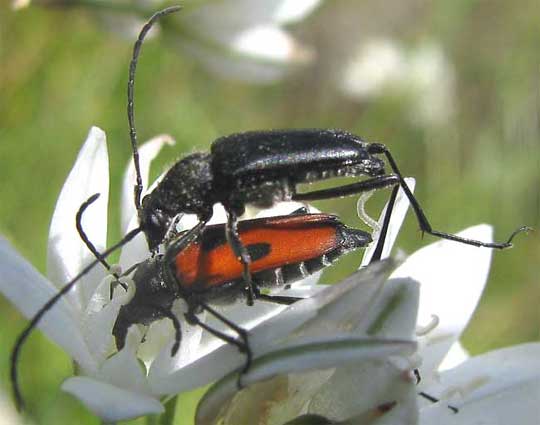

English Name: Dimorphic Flower Longhorn Beetle
Family: Cerambycidae (longhorn beetles & kin)
Genus: Anastrangalia
Species: laetifica
The neat thing about the above picture is the slender, segmented, pale item connecting the two beetles' rear ends. That's the aedeagus, which is a hardened, ringed sheath at the tip of which lies a less hardened area, the "internal sac," which delivers sperm to the female. In the picture the internal sac is inside the female so all you're seeing is the aedeagus. When not copulating, the aedeagus and internal sac reside inside the male beetle but in preparation for sex the aedeagus "everts," or turns inside out, exiting the body to be what you see. Other insects possess aedeagi in different shapes and sizes. Longhorn beetles in general have spectacular ones, and among the many species of longhorn beetles aedaegus sizes and shapes vary a lot.
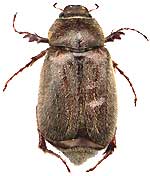 English Name: Asiatic Garden Beetle
English Name: Asiatic Garden Beetle
Family: Scarabaeidae (scarab beetles)
Genus: Autoserica
Species: castanea
This looks a lot like the very common Junebug, of which there are over 100 North American species! However, it's a species introduced from Asia, one of those bugs that has "gone wild" in North America, causing incredible damage, especially in gardens, where I found this one. In North America this species was first found 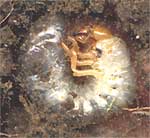 in New Jersey in 1922, and now I have found this one in southwestern Mississippi! Asiatic Garden Beetles spend the winter as grubs like the one shown at the left, burrowing 8 to 10 inches deep. In the spring they return to the surface where they feed on roots until metamorphosing into a brownish pupa in late spring or summer. Adults emerge from the pupa in the summer and eat foliage until frost. Females tend to choose weedy or grassy areas in which to lay their eggs. This insect, along with June Bugs, is a member of the largest beetle family, the Scarab Beetle Family, of which there are about 1,300 North American species. Once you begin looking at insects you'll find Scarabaeidae again and again. Most scarab beetles are oval or elongate, stout and heavy-bodied, just like this species.
in New Jersey in 1922, and now I have found this one in southwestern Mississippi! Asiatic Garden Beetles spend the winter as grubs like the one shown at the left, burrowing 8 to 10 inches deep. In the spring they return to the surface where they feed on roots until metamorphosing into a brownish pupa in late spring or summer. Adults emerge from the pupa in the summer and eat foliage until frost. Females tend to choose weedy or grassy areas in which to lay their eggs. This insect, along with June Bugs, is a member of the largest beetle family, the Scarab Beetle Family, of which there are about 1,300 North American species. Once you begin looking at insects you'll find Scarabaeidae again and again. Most scarab beetles are oval or elongate, stout and heavy-bodied, just like this species.
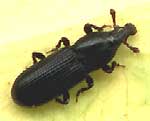 English Name: Snout Beetle
English Name: Snout Beetle
Family: Curculionidae (snout beetles)
Genus: ?
Species: ?
The Snout Beetle Family is one of the largest insect families (over 2,500 species just in North America), and that's lucky because they're also one of the easiest families to identify. Do you see the long "snout" at the end of the head? Also, notice that the antenna seem to arise from the snout instead of back on the head. This is a good family to know because nearly all feed on plants and often occur in such large numbers that they harm crops. Many chew holes in fruits, nuts and other plant parts. The Boll Weevil of cotton-eating fame is a snout beetle.
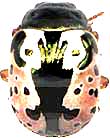 English Name: Elm Calligraph
English Name: Elm Calligraph
Family: Chrysomelidae (leaf beetles)
Genus: Calligrapha
Species: scalaris
Though my scanned image doesn't support the claim, this is one of the prettiest of all beetles. In real life its gold center stripe shimmers in the sunlight and the whitish part of the back is like ivory. One reason I'm keeping the image, despite it's not turning out too well, is that I want to remind everyone that it's good to look at insects not only because they are interesting and satisfy our brains, but also because they are often beautiful, and being around beautiful things is pleasing. This species eats vegetation. Though it is called Elm Calligraph, I found it on a Hophornbeam tree.
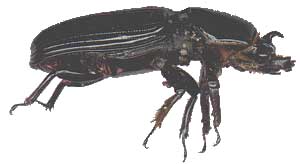
English Name: Bessbug
Family: Passalidae (bessbugs)
Genus: Popilius
Species: disjunctus
One morning in spring I stepped from my trailer and on the ground before me was the beetle shown above, dead from unknown causes. It's about 1¼-inch long (33 mm). Three Bessbug species occur in the US but only this one lives in the East. The conspicuous curved "horn" atop his head is the main feature making this a Bessbug. The books say that this species occurs in colonies in well-decayed logs and stumps, but I suspect that they do something other than hang around in rotten logs and stumps because I've found several in open places, like this one. Maybe they fly around at night. Maybe when they mate the male goes off and dies. This would be a good research project, if someone hasn't already done it. Despite that curved horn on his head and some mean-looking mouth parts, members of the family don't bite. They do make sounds, however, even the larvae. Sometimes they are called "Patent-leather Beetles," "Betsy-beetles," and
"Horned Passalus Beetles."